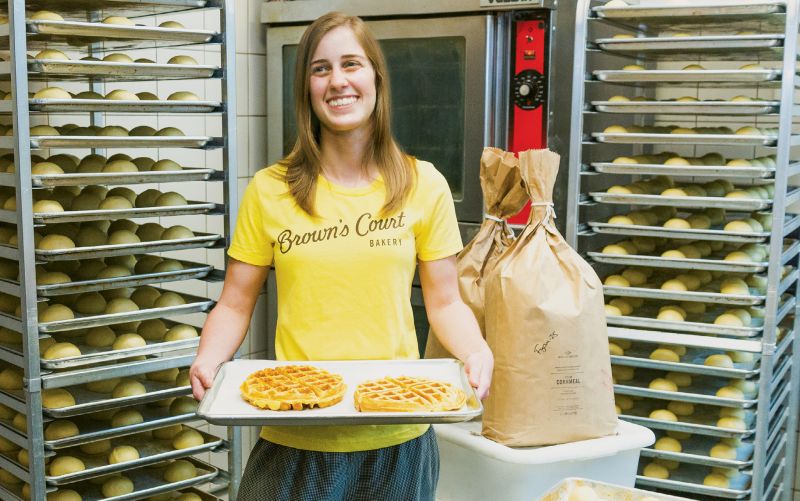
Restaurant: Brown’s Court Bakery
First F&B Gig: “I was a culinary intern at the Fearrington House Restaurant in Pittsboro, North Carolina, though my first permanent job was at High Cotton doing everything dessert-related.”
Education: A bachelor’s degree in culinary arts from New England Culinary Institute and an associate’s degree in baking and pastry
Favorite Local Ingrediaent: Peaches
Recipe She’ll Never Share: “Popcorn semifreddo”
If you’re only familiar with the cornmeal that sits on any supermarket shelf, you may want to rethink your relationship to the staple. Ground with metal rollers whose friction heats force-dried kernels, commercial cornmeal is robbed of hull and germ, taste and texture.
That’s why Brown’s Court Bakery pastry chef Carrie-Ann Bach bakes exclusively with Anson Mills stone-ground yellow cornmeal. “It’s a local product, ground fresh every week, which gives it a richer flavor and aroma,” she says. “I prefer the fine grind because of its smooth mouthfeel.”
What does Bach mean by “local”? “We fresh mill each state’s grain to send to chefs in those locations,” explains Anson Mills owner Glenn Roberts. “So chefs in South Carolina receive ingredients milled from grains grown in South Carolina,” just as a chef in Georgia would get ingredients from Georgia. Anson Mills field-ripens its corn by leaving it in the field to dry naturally, then keeps it in freezers after harvesting. “We mill fresh to order three times per week and ship the same day,” he continues. (Read more about Anson Mills cornmeal and how to store it on page 148.)
Since the proof of the pudding is in the eating, Bach whipped up three recipes with Anson Mills Antebellum Yellow Cornmeal. It gives her waffles a crunchy exterior and what she characterizes as a “pillowy” inside. She pairs them with a sweet strawberry-peach jam softened by a short turn on the stove and a rich lemon-kissed crème fraîche.
Bach’s tasty apple fritter hush puppies were inspired by fried fruit-studded dropped donuts sold in her Connecticut hometown. “But these classify as hush puppies since they’re made with a cornmeal batter,” she says. “They have a lightly crisp shell surrounding a tender center loaded with tart Granny Smith apple.” The coating brings sugar and spice to each bite.
Made with corn since the 17th century, polenta, at its most basic, is cornmeal porridge. When cooked simply in salted water, without any enrichment, polenta will only be as good as the cornmeal in it. Freshly milled Anson Mills cornmeal in Bach’s Northern Italian peasant dish, polenta concia, lets the corn flavor shine. Gently simmered to swell the grain, layered with cheese, and doused with warm cream and garlic-infused butter, it’s comfort food at its finest.